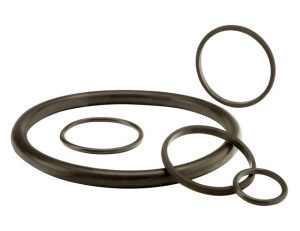Article re-posted with permission from Parker Hannifin Sealing & Shielding Team.
Original content can be found on Parker’s Website and was written by Dorothy Kern, applications engineering manager for the Parker O-Ring & Engineered Seals Division.
Perhaps you know Parker’s newest EPDM material is EM163-80. Featuring breakthrough low temperature functionality, resistance to all commercially available phosphate ester fluids, and the ability to be made into custom shapes, extrusions, and spliced geometries, EM163-80 represents the best-in-class material for applications needing to seal phosphate-ester-based fluids. The latest news is that EM163-80 meets the full qualification requirements of both NAS1613 Revision 6 (code A) and the legacy Revision 2 (no code). Parker has been inundated with questions about the specification differences between Revision 6 and 2, enough that it makes sense to devote a blog topic explaining the fluids, conditions, and dynamic cycling requirements which are required to qualify EM163-80 to each specification.
The easiest part of this comparison is evaluating the areas of Revision 6 which are very much a copy and paste from Revision 2. Compression set conditions, aged and un-aged, plus temperature retraction requirements, aged and un-aged, are identical. Lastly, both specifications require a test to verify the elastomers will not corrode or adhere to five different metal substrate materials. That is pretty much where the similarities end. Now for the contrasts.
Specimen size
The first subtle difference is the specimen size. Both specs require testing to measure the change in physical properties and volume following a heated immersion in phosphate ester fluids. For the most part, No Code qualification requires testing to be completed on test slabs or O-rings, while the newer revision, Code A, requires testing on test slabs AND O-rings. Not a big difference, but still, a difference.
The fluid conditions are very similar in both specs, but not identical. There are only two temperatures for the short term 70 hour exposure: 160°F and 250°F. Another similarity is that the longer soaks are at 225°F for 334 and 670 hours. The more difficult A Code also requires 1000 and 1440 hours at 225°F. We begin to see the requirements for the later revision are more reflective of the industry conditions, right?
Fluids
Next, we look at the fluids, which truly are a key difference between the two documents. Revision 2 fluid is exclusively for AS1241 Type IV, CL 2 while revision 6 states the elastomers must meet “all commercially available AS1241 Type IV, Class 1 and 2, and Type V”. Table 1 outlines the AS1241 fluids in context of both NAS 1613 revisions.
| Revision 2 | Revision 6 | ||
|---|---|---|---|
| Low Density Hyject IV A Plus | AS 1241 Type IV class 1 | X | |
| Low Density Skydrol LD4 | AS 1241 Type IV class 1 | X | |
| High Density Skydrol 500B-4 | AS 1241 Type IV class 2 | X | X |
| Low Density Skydrol V | AS 1241 Type V | X | |
| Low Density Hyjet V | AS 1241 Type V | X | |
| Low Density Skydrol PE-5 | AS 1241 Type V | X |
Basically, to pass Revision 6, the material must demonstrate compatibility for all six commercially available fluids, while Revision 2 only has one fluid which is must be verified for compatibility. Again, we see Revision 6 is much more comprehensive than Revision 2.
Endurance Testing

Revision 2 has a gland design per Mil-G-5514. There is a 4” stroke length and the rod must travel 30 full cycles each minute. The rod is chromium plated with a surface finish between 16-32 microinches. PTFE anti-extrusion back up rings are necessary for the 3000 psi high pressure cycling. A temperature of 160°F is maintained for 70,000 strokes and then increased to 225°F for an additional 90,000 strokes.
Revision 6 has a much more demanding endurance test with fives phases and slightly different hardware. The rod must be a smooth 8 to 16 microinches Ra with a cross-hatched finish by lapping, and the cycle is 30 complete strokes per minute but only 3” rather than 4”, which means the speed can be more conservative. A pair of conditioned seals are placed in AS4716 grooves, adjacent to a PTFE back up ring. Similarities to Rev 2 are that there is a pressure of 3000 psi for the dynamic cycling at both 160°F and 225°F, however before and after each high temperature cycle there is a low temperature, -65°F soak. The first soak is static for 24 hours, followed by the 160°F high pressure cycling. The second low temperature soak requires 10 dynamic cycles at ambient pressure followed by 10 cycles at 3000 psi. The final low temperature soak requires one hour static sealing at 3000 psi followed by an 18 hour warm down period.
If you read carefully through the tests, you begin to see the Revision 6 seals must go through a more rigorous test with harsh low temperature, low pressure conditions. However, Revision 2 is not without its own challenges. The required hardware configuration; ie, low squeeze and more rough surface finish, is far from optimum and not what we recommend in actual service conditions. Added to the difficulty is the longer stroke length and faster speed. The fact that EM163-80 has passed both specifications proves it is the next generation EPDM seal material ready for flight.
Gallagher Fluid Seals is an authorized distributor of Parker. To learn more about how Gallagher Fluid Seals can help you, contact our engineering department at 1-800-822-4063
